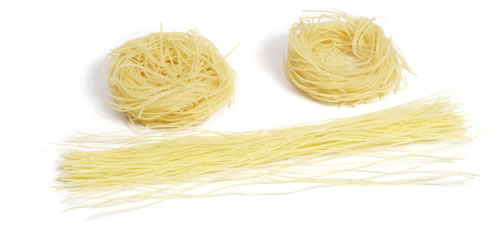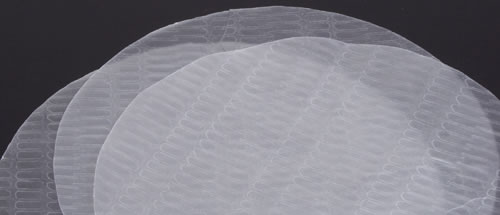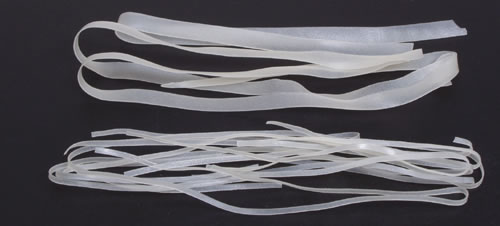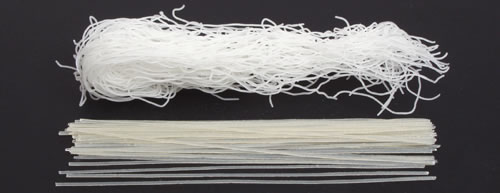|
Asian Noodles |
|
Pasta |
Description |
Estimated
Cooking Time |
| Arrowroot vermicelli |
Thin white, semi-transparent noodles
that are made from arrowroot starch. They are similar to
cellophane noodles in appearance. |
Cook for 2 to 4 minutes, until
tender. |
Canton noodles
 |
Long egg noodles that have been
precooked and dried before packaged. They are found as flat or
round noodles and because they are precooked they require only
a short cooking time. |
Cook for 3 to 4 minutes. |
|
Cellophane noodles (mung bean thread
noodles)

Cellophane noodles are thin translucent noodles
made from mung bean starch. Also known as bean thread noodles
and glass noodles. The dried noodles have a slippery texture
when cooked. The noodles should be soaked before cooking.
Cellophane noodles can also be deep-fried. They are sold in
bundles.
To prepare: Soak by
placing the noodles in a heatproof bowl and pouring hot or
boiling water over them. Let them soak for 5 to 15 minutes,
just until tender. If adding to a soup, it is not necessary to
soak the noodles before adding them. Do not soak if you are
deep-frying the noodles.
Cooking Time: Cook the noodles by adding
to boiling water and cooking for 1 to 3 minutes. |
|
Chinese egg noodles (dan mien)

Long noodles made with wheat flour and eggs. They are
available as a round noodle in various thicknesses and can
also be fond as a flattened noodle in various widths. Chinese
egg noodles are golden yellow in color and generally found
wrapped tightly in a bundle or nest. They should be cooked
similar to Italian egg noodles.
Cooking Time: Dried noodles - Cook
in boiling water for 3 to 6 minutes, depending on size.
If adding to a soup, slightly undercook the noodles.
Fresh noodles - Cook for
1 to 3 minutes. If adding to a soup, fresh noodles can
be added without precooking.
|
|
Chinese wheat noodles

Long round or flat noodles made with wheat, water and salt.
They are found in various thicknesses and are generally white
or light yellow-beige in color.
Cooking Time: Dried Noodles - Cook
in boiling water for 4 to 7 minutes, depending on size.
Fresh Noodles - Cook for 2 to 4 minutes.
|
|
Chuka Soba
 |
Long and wavy, dried Japanese noodles
made from wheat flour. They have a mild flavor and are fine
textured. They are packaged in brick form similar to ramen
noodles. Chuka soba noodles are much lower in fat than ramen
noodles because they are not fried in oil as ramen noodles are
before they are dried. They are often used as a substitute for
ramen noodles. |
Cook in boiling water for 2 to 3
minutes. |
|
E-fu noodles (yee-fu
noodles)

Long flat egg noodles that have been deep-fried in a
flattened nest shape and then dried. The fried noodle cakes
are fragile so they need to be handled with care.
Cooking Time: Cook in boiling water
for 1 to 3 minutes to soften. |
Fried chow mein
noodles
 |
Short lengths of deep-fried egg
noodles that have been cooked until they are brown and
crunchy. Added to salads and other dishes to provide a crunchy
texture.
|
Additional cooking is not required.
|
|
Gook soo (gougsou)

A thin, pale colored Korean noodle made with wheat flour.
They are available as flat narrow rods or thin round rods.
Also found spelled as Kuk Soo.
Cooking Time: Cook in boiling water
for 3 to 5 minutes until al dente. Do not overcook. |
|
Harusame

A Japanese noodle that is thin and translucent in
appearance, similar to cellophane noodles. They are made from
potato, rice, corn, or mung bean starches. Harusame noodles
are round or flat thin rods that are generally 5 to 7 inches
in length. They are also found as long, thin delicate noodles
gathered in tight bundles.
To prepare: The noodles should be
soaked before cooking. Soak in hot water for 5 to 15 minutes,
just until tender. If adding to a soup, it is not necessary to
soak the noodles before adding them. Do not soak if you are
deep-frying the noodles.
Cooking Time: Finish cooking by
adding to boiling water and cooking for 1 to 3 minutes.
Harusame can also be deep-fried, which would not require
soaking the noodles beforehand. |
|
Hiyamugi

Thin, fragile, white Japanese noodles made from wheat
flour. They are sold in straight strands that are dried and
bundled. Occasionally the bundles will contain a couple brown
or light pink strands. Hiyamugi is generally served cold with
dipping sauces.
Cooking Time: Cook for 4 to 6
minutes, just until tender. |
| Hokkien |
Thick, meaty fresh egg noodles that are popular for stir
frying because their size allows them to pick up more sauce
and provide more flavor. They are long strands of thick
spaghetti-like noodles. Sold fresh or in vacuum sealed
packages.
To prepare: Place noodles in a
heatproof bowl and pour boiling water over the noodles. Let
them stand for 1 to 2 minutes and drain. |
Further cooking is accomplished when
the noodles are added to a stir-fry dish or to a soup. |
|
Korean sweet potato vermicelli (dang myun)

A Korean noodle made from sweet potato starch. It is a thin
long, translucent noodle with a chewy texture. They are
similar to cellophane noodles, except they are slightly
thicker and tougher.
To prepare: Place the noodles in a
heatproof bowl, pour boiling water over the noodles, and let
them stand for 10 to 15 minutes, until noodles have soften.
Cooking Time: When the noodles are
added to a stir-fry or to soup, further cooking is
accomplished during the cooking of the dish.
When adding to a dish in which the noodles will not receive
additional cooking time, add the noodles to boiling water and
cook for 3 to 5 minutes before adding to the dish. |
|
Korean buckwheat noodles (naeng
myun)

Korean noodles made from buckwheat flour and potato starch.
They are brownish in color with a translucent appearance. The
noodles are most often eaten cold but at times they are added
to soup.
Cooking Time: Cook in boiling water
for 2 to 4 minutes if noodles are dried, if fresh or frozen,
cook just long enough to soften. |
|
Miswa (misua)

Long Philippine wheat noodles, which are very fine and
delicate. They are slightly off-white in color.
Cooking Time: The noodles can be
boiled for 1 to 3 minutes or they can be added directly to
soup without precooking. Miswa noodles can also be quickly
deep-fried in oil. |
|
Ramen

A long thin noodle made with wheat flour. Some ramen
noodles also contain eggs. The off-white noodle is very
popular all over the world and is available in straight rods
or crinkled into a brick shape. It is sold fresh, dried,
frozen and in instant form, which generally includes a flavor
packet. Instant ramen noodles have been deep-fried before they
are dried to assist in removing some of the moisture. There is
also a low-fat variety that is made by using a blow-drying
method to remove the moisture, rather than deep-frying.
Cooking Time: Fresh: Cook in boiling water for 2 to 3
minutes. Dried: Cook in boiling water
for 4 to 6 minutes. Instant: Follow
package directions. |
|
Rice Macaroni

|
White translucent, slightly curved,
thin tubes that are approximately 1 inch long. Rice macaroni
is made from rice flour. |
Cook for 9 to 12 minutes. |
|
Rice noodles
Rice
Paper
Rice
Sticks
Rice
Vermicelli |
White translucent noodles made from rice flour, which are
available in various widths and thicknesses. The different
varieties of rice noodles include rice paper, rice sticks, and
rice vermicelli. Several cooking methods are used in cooking
rice noodles - see individual varieties.
To prepare: Soak noodles in hot
water for 15 to 20 minutes until they have softened. |
When boiling, cooking time
will vary according to the variety of rice noodles being
cooked. Thin noodles such as vermicelli should be cooked for 3
to 5 minutes and the thicker noodles should be cooked for 7 to
9 minutes. |
|
Rice paper

Circle or triangle shaped sheets made from rice flour and
water. They are generally found dried and require soaking
before using so they soften enough to allow them to be rolled
up. The papers are used to wrap ingredients similar to a
spring roll wrapper.
Cooking Time: Deep-fry until golden
brown. |
|
Rice Sticks

A variety of dried rice noodles similar to rice vermicelli,
only they are thicker and wider. They are white and
translucent in color and are available in a variety of shapes
and sizes, ranging from thin to a width of more than ¼
inch.
To prepare: Soak in hot water anywhere from 5 to 30
minutes, depending on the size of the rice sticks and cooking
method to be used.
To stir-fry:
Soak for 15 to 25 minutes and add directly to the
stir-fry.
Adding to soup: Soak for
5 to 10 minutes to soften and then add to the soup (or salted
water). Rice sticks can also be added directly to the soup
without soaking first but will require a little more cooking
time.
Cooking Time: To
stir-fry: Cook for 1 to 2 minutes.
Soup: Boil for 2 to 3 minutes. |
|
Rice vermicelli
(mi-fun)

Long, thin, brittle noodles made from rice flour. They are
white and translucent in color. Rice vermicelli is similar to
cellophane noodles, except that it is made from rice flour
rather than mung bean starch.
To prepare: Place noodles in a
heatproof bowl and pour boiling water over them. Let the
noodles stand for 5 to 7 minutes, or place the noodles in cold
water and allow them soak for 25 to 30 minutes. Rinse, drain,
and then add to boiling water.
Cooking Time: Cook for 1 to 2 minutes. If adding to
soup, only cook for 1 minute. Rice vermicelli can also be
deep-fried. When deep-frying, add noodles to oil without
presoaking. |
Saimin
 |
A long crinkled noodle similar to
ramen noodles. The differences are that saimin noodles contain
eggs and are not deep-fried. Saimin is available fresh or
dried. Dried saimin is very brittle and must be handled
carefully. |
Cook for 1 to 3 minutes. |
|
Shanghai noodles

An 1/8 inch thick egg noodle made with semolina flour. It
is generally found fresh but is also available in thin dried
rods.
Cooking Time: Fresh: Cook for 3 to 5 minutes. Dried: Cook for 5 to 7 minutes. |
|
Shirataki

Thin, long, translucent noodles made from very fine strands
of a gelatinous substance called konnyaku, which is taken from
the "devil's tongue plant" (Japanese yam). Their texture is
slightly rubbery and they do not have any flavor. The noodles
will pick up the flavor of the broth or other ingredients in
the dish in which they are simmered. They are available dried
or packaged in water in a plastic casing that gives it a
sausage-like shape. They are also found packaged in cans.
To prepare: Noodles that are
packaged in water should be drained and the noodles rinsed in
cold water.
Cooking Time: Water packed: Add to
boiling water and allow noodles to simmer for 5 minutes or
parboil for 2 minutes. Dried: Add to
boiling water and allow noodles to simmer for 6 or 7
minutes. |
|
Soba

A flat noodle made from a mixture of buckwheat flour and
standard wheat flour. Soba has a nutty flavor and the noodles
have a slightly flecked color ranging from light beige to
brownish gray. It is also available in a green color, which is
produced by adding ground green tea to the dough when the
noodles are being made. They are most often found dried but
they can also be found fresh in Japanese markets.
Cooking Time: Fresh: To cook fresh noodles add to boiling
water and cook for 2 to 4 minutes. Dried: Add to boiling water and cook for 5
to 7 minutes. |
|
Somen

A thin, round, white noodle made from wheat flour. It is
similar to vermicelli. Strands of somen are generally found
dried and often packaged in band tied bundles.
Cooking Time: Cook in boiling water
for 2 to 4 minutes. |
|
Taiwanese noodles

Very thin, long noodles made in Taiwan. They are generally
made with whole-wheat but can be found flavored with yam,
green tea, and blue-green algae.
Cooking Time: Cook for 4 to 6
minutes. |
| Tofu noodles |
Narrow, flat noodles that resembles a rubber band. They are
made from compressed tofu, which provides them with a large
amount of protein and nutrients. The have a chewing texture
and are used in stir-fries, soups and salads. They are found
fresh and frozen in Asian markets. Tofu noodles are also
available dried.
To prepare:
Fresh: Rinse the tofu off and pat dry before
adding to the dish in which it will be cooked.
Dried: Soak the tofu in water that contains
baking soda until the noodles soften, approximately 15
minutes. Drain and rinse the noodles before adding to the dish
in which it will be cooked. |
Add to the dish in which it will be
cooked and cook according to directions. |
|
Udon

A thick, white noodle made from wheat flour and water. Udon
noodles have a slippery texture and are most often served in
soups or stews, but they also work well in braised dishes or
served cold. Fresh noodles are generally thick and square in
shape.

Dried noodles are available in flat and round shapes. There
are also square shaped, precooked, instant noodles that are
package in a square block wrapped in cellophane.
Cooking Time: Fresh: Add to boiling water and cook for 2
to 4 minutes. Dried: Add to boiling
water, allow water to come back to a boil and then add a cup
of cold water. When it returns to a boil again, add another
cup of cold water. Repeat this process 2 or 3 more times until
the noodles are cooked to their "al dente" state, which is
tender but still having a slightly firm bite. Instant: Place noodles in a heatproof bowl
and pour boiling water over them and carefully separate the
noodles. When noodles are separated, rinse with cold water and
drain. |
|
Wonton noodles

|
Very thin egg noodles, which are
available in various widths. Wonton noodles are generally used
in soups. They were named after the stuffed wontons that were
part of the soups in which the noodles were added. They are
available fresh and dried. If adding fresh or dried wonton
noodles to soup, it is better to undercook them to prevent
them from becoming overcooked. |
Fresh: Add to
boiling water and check for doneness in 30 seconds. Do not
allow noodles to overcook.
Dried:
Add to boiling water and cook for 4 to 6 minutes.
|